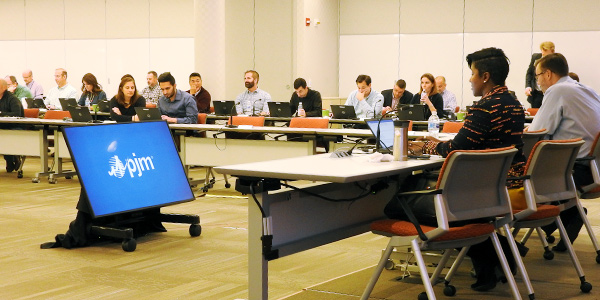VALLEY FORGE, Pa. — PJM’s Operating Committee put manual revisions for its gas contingency rules on the fast track to endorsement on Tuesday after approving the changes on the first read.
Chris Pilong, PJM director of dispatch, told members old gas contingency procedures will be deleted from Manual 3 Section 5 and changes in Manual 13 Section 3.9 will remove references to PJM-directed precontingency fuel switching. Instead, the RTO will “discuss” any threats to fuel supply with the generator and request notification should that generator voluntarily decide to take any precontingency action to mitigate those risks.
The subtle language change signals a victory for generators who repeatedly expressed concern about PJM’s authority to direct pipeline switches — particularly after its revised gas contingency filing significantly redefined how resources can seek cost recovery after-the-fact. (See PJM Stakeholders: Gas Contingency Filing ‘Too Vague.’)
PJM will seek endorsement from the Markets and Reliability Committee on Oct. 31, with a scheduled effective date of Nov. 1.
Second PFR Evaluation
PJM’s second analysis of resources that provide primary frequency response (PFR) looked a lot like its first — low participation across the board. (See “First Primary Frequency Response Evaluation Reveals Low Participation” in PJM OC Briefs: June 11, 2019.)
PFR is the ability of generators to automatically change their output in five to 15 seconds when the grid’s frequency strays above or below 60 Hz. As more renewables enter the resource mix and coal plants retire, the grid can become more susceptible to these frequency swings, threatening system reliability.
PJM said 583 units with capacities of 50 MW or greater were evaluated for PFR across 10 events between March and September. The selected events for analysis met one of three qualifications: frequency goes outside the +/- 40-mHz deadband, frequency stays outside the +/- 40-mHz deadband for 60 continuous seconds or minimum/maximum frequency reaches +/- 53 mHz.
No more than 28 units provided PFR during any of the selected events. In some cases, no units responded. PJM said most critical load and black start units evaluated did not provide PFR because many were offline, operating at maximum capacity or had inconclusive results.
PJM will continue outreach to generators to better understand the low participation rates. A final analysis will be presented to the OC in January.
Winter Weekly Reserve Target
PJM’s weekly winter reserve targets for 2019 remain unchanged from last year.
The targets — part of the reserve requirement study — help the Operations Department coordinate planned generator maintenance scheduling during the winter and cover against uncertainties associated with load and forced outages.
PJM also sets a 0% goal for its loss of load expectation (LOLE) in the winter, preferring instead to expect higher LOLEs throughout the summer. The 2019 targets for December, January and February are 22%, 28% and 24%, respectively.
The OC will endorse the targets at its November meeting.
Preliminary Day-ahead Scheduling Reserve Requirement
PJM’s day-ahead scheduling reserve requirement decreased slightly from 5.29% to 5.12%.
The DASR is the sum of the requirements for all zones within PJM and any additional reserves scheduled in response to a weather alert or other conservative operations.
PJM will seek endorsement for the change at the November MRC and implement the new requirement in Manual 13 revisions.
PJM/NYISO Operational Base Flow Set to Zero
PJM and NYISO agreed to set an operational base flow (OBF) that once provided flexibility between the systems down to zero by month’s end.
The OBF, established in May 2017, carried a 400-MW limit and managed power flows over the Waldwick and ABC phase angle regulators (PARs) to account for natural system flows over the JK and ABC interfaces. PARs are power system transformers that have tap changing capability and can change the phase angle across the transformer and thereby increase or decrease power flow.
Outages on the Hudson-Farragut and Marion-Farragut lines resulted in a decreased limit of just 100 MW as of January 2018. PJM said on Tuesday both systems agreed to set the limit to zero at 11:59 p.m. on Oct. 31.
– Christen Smith


